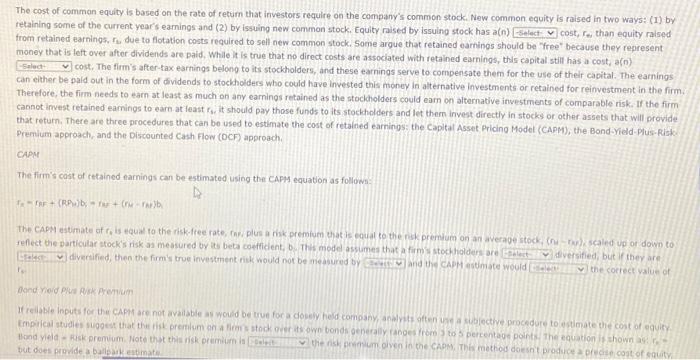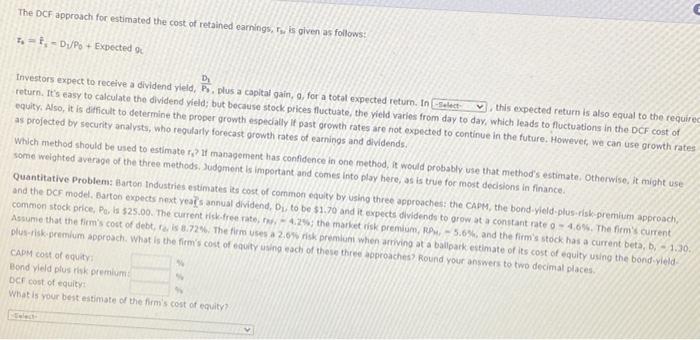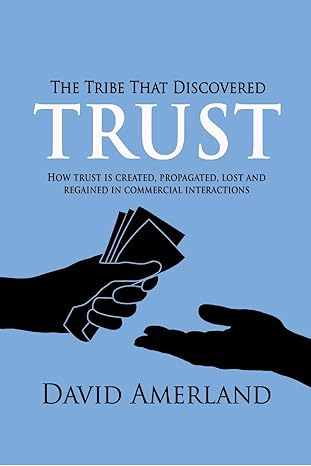The cost of common equity is based on the rate of return that investors require on the company's common stock. New common equity is raised in two ways: (1) by retaining some of the current year's earnings and (2) by issuing new common stock. Equity raised by issuing stock has alr) Select cost, fa, than equity raised from retained earnings. I due to flotation costs required to sell new common stock. Some argue that retained earnings should be "free" because they represent money that is left over after dividends are paid. While it is true that no direct costs are associated with retained earnings, this capital still has a cost, a(n) Select cost. The firm's after-tax earnings belong to its stockholders, and these earnings serve to compensate them for the use of their capital. The earnings can either be paid out in the form of dividends to stockholders who could have invested this money in alternative Investments or retained for reinvestment in the firm Therefore, the firm needs to earn at least as much on any earnings retained as the stockholders could eam on alternative investments of comparable risk. If the firm cannot invest retained earnings to earn at leastIt should pay those funds to its stockholders and let them invest directly in stocks or other assets that will provide that return. There are three procedures that can be used to estimate the cost of retained earnings the Capital Asset Pricing Model (CAPM), the Bond Vield Plus Risk Premium approach, and the Discounted Cash Flow (DCF) approach CAPM The firm's cost of retained earnings can be estimated using the CAPM equation as follows: + ( RD) The CAPM state of rise to the risk-free rate, plus ar premium that is equal to the premium on an average stock, in scaled up or down to reflect the particular stock's risk as measured by its beta coefficient. This model assumes that a firm stockholders are diversified, but if they are La diversified, then the firm's true investment risk would not be measured by and UCAPM estimate would the correct value of cond yid PW Premium fellable inputs for the CAPM are not available as would be true fora dovely held company is often subjective procedure to estimate the cost of equity Empirical studies suggest that this premium on stock over own bond generally ranges from 3 to 5 percentage points. The equation is shown Hand vid-Risk premium. Note that this is priminis the men in the CAM method doesn't produce e cost of equity but does provide ballar estimat The DCF approach for estimated the cost of retained earnings. To is given as follows: I, E, D/P + Expected D Investors expect to receive a dividend yield, plus a capital gain, a, for a total expected return. In Select this expected return is also equal to the required return. It's easy to calculate the dividend yield; but because stock prices fluctuate, the yield varies from day to day, which leads to fluctuations in the DCF cost of equity, Also, it is difficult to determine the proper growth especially if past growth rates are not expected to continue in the future. However, we can use growth rates as projected by security analysts, who regularly forecast growth rates of earnings and dividends. Which method should be used to estimater management has confidence in one method, it would probably use that method's estimate. Otherwise, it might use some weighted average of the three methods. Judgment is important and comes into play here, as is true for most decisions in finance. Quantitative Problems Barton Industries estimates its cost of common equity by using three approaches the CAP, the bond yield plus-risk premium approach and the DCF model. Barton expects next years annual dividend. Di, to be 51.70 and it expects dividends to grow at constant rate 0 - 4.6%. The firm's current common stock price, Po s 525.00. The current risk-freerite, -42%; the market risk premium, - 5.6% and the firm's stock has a current beta, , - 130. Assume that the firm's cost of debt, is 8.72. The firm ses a 2.6% risk premium when arriving at a ballpark estimate of its cost of equity using the bond yield plus-risk premium approach. What is the firm's cost of equity using each of these three soproaches Round your answers to two decimal places CADM Cost of equity Bond Vield plus risk premium DCF cost of equity What is your best estimate of the firm's cost of equity








